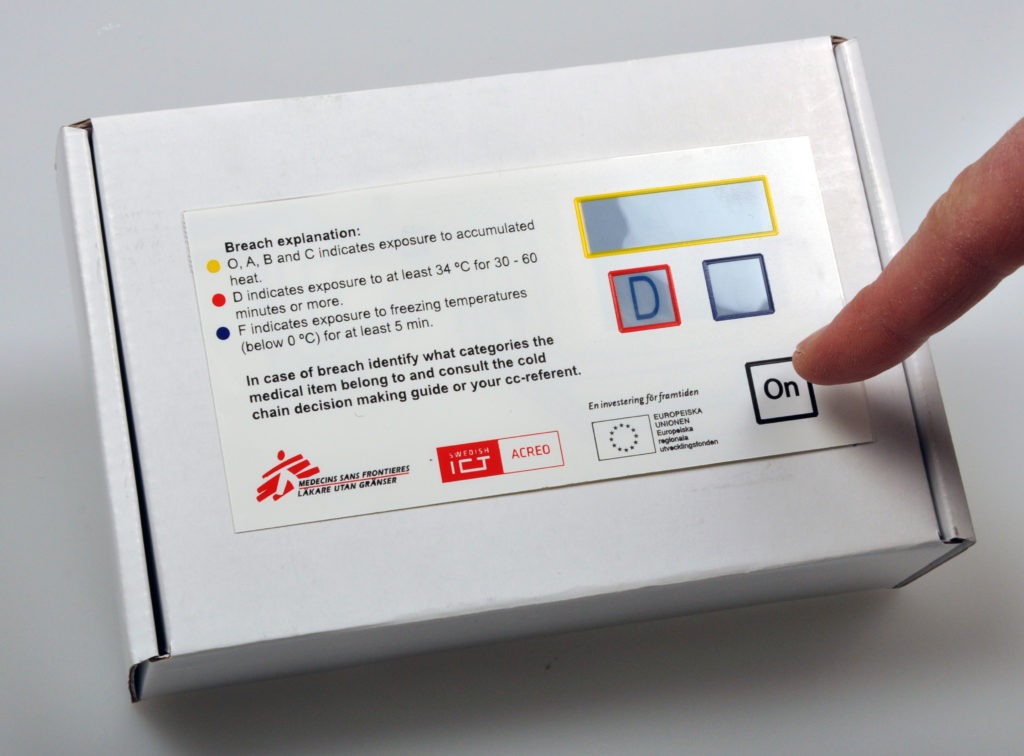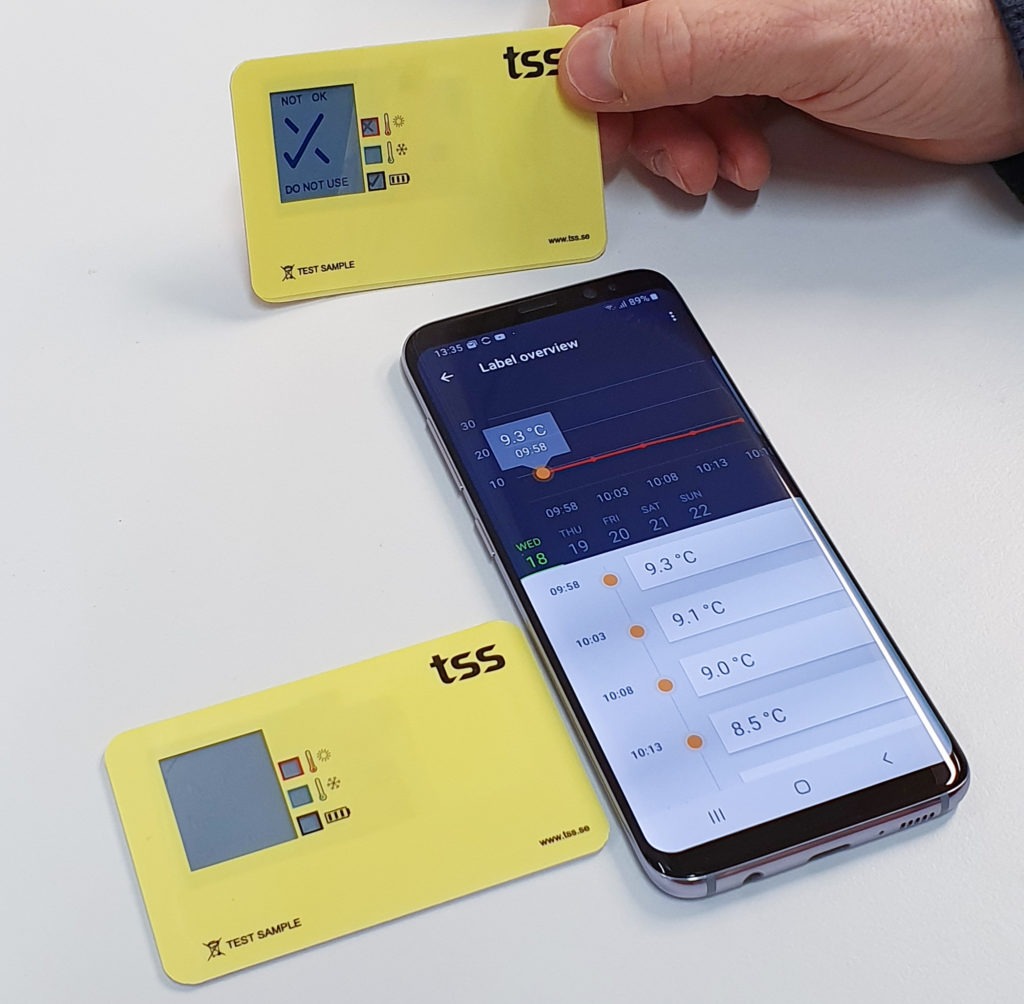Smart Labels for Cold Chains
Smart Labels for Cold Chains
“RISE has contributed insight and knowledge about printed electronics, which has been a key component of the project.”
Having control of cold chains is something that is needed in many areas of application. The Smart Cold Chain Indicator, sCCI, which is a smart label for temperature logging, can accomplish this for medical transports and within other areas. At RISE, the unit Printed Electronics, we have developed smart labels for temperature monitoring through various collaborations. The use of these temperature loggers leads to safer transport, which in turn leads to more accurate measurements, as well as lower costs. The loggers reduce the number of errors in the field, where the simpler communication equipment usually work better than the advanced ones. Drugs such as vaccines and insulin, are affected by temperature fluctuations. To ensure that they are effective, cold chain transports in pharmacology are monitored with temperature loggers, that can indicate whether exposure outside permitted temperature values has occurred.
Cold Chain Monitoring is an important area for the world’s pharmaceutical companies, as large quantities and costs are involved. Within humanitarian care there are several organizations that are working with Cold Chain problematics, such as: PATH, GAVI, WHO, Unicef and Médicins Sans Frontières (MSF). After extensive studies by MSF on how vaccines are transported and handled in their cold chain, they came up with the idea of developing a smarter and cheaper temperature logger. At the same time as MSF conducted these studies, we at Printed Electronics Arena at RISE started developing an Open Innovation Platform “PEA Open”. This was funded by the European Development Fund, which focused on a Sensor Platform developed by us at RISE. Through this platform we came into contact with MSF, who had identified a need in the humanitarian sector. First, the demonstrator was developed with internal funds from RISE to demonstrate the concept. What is unique about our system, is that RISE ECD offers an opportunity to make temperature readings in the field, as the icons shown on the display will indicate if it is too hot or too cold, without any external aids required. In addition, there is a possibility to download all the history of one specific transport, which can then be used to analyze where the transport chain was faulty.
- The first demonstrator
- The final version
The demonstrator was the basis for the subsequent applications. MSF has conducted a comprehensive needs analysis parallel to our project, which can be found here: Cold Chain Indicator.
Two development projects have been funded by Vinnova for the technical development of the system. The first project involved several parties and focused on developing a few systems as proof of concept, as well as doing a smaller field test to assess performance, robustness and ease of use. During the first project the MSF Sweden innovation Unit performed field studies on usability, where they are responsible for the design used today. The second project, which was active until 2019, centered around scaling up production. Presently there are 1000 labels which were manufactured and delivered to TSS, so that they can evaluate them, together with their customers.
RISE’s role in this project has been both as project manager, as well as an executor for the technical development from system solution, software to production methods. Through the Test and the Demo plant Printed Electronics Arena (PEA), the project has been able to develop from idea to pilot production. This has been done in close collaboration with the various partners TSS, Note, Beneli, Flex, and MSF, who have contributed with requirements and different production methods.
The system is based on a printing technology in combination with standard components in the electronics industry.
The system is made up of:
- conductor tracks
- NFC antenna
- Thin flat batteries (fitted)
- Graphic printing
- Printed electrochromic display (“RISE ECD”)
- Microcontrollers for data management and storage of measuring points.
The user configures the label for the specific shipment via an app. The desired configuration is transferred to the label via NFC and at the same time the temperature logging starts. Logging is done by registering temperature values at set time intervals. Whenever the user wishes, they can read the results during the transport chain. This can be done via a smartphone or tablet, with NFC via an app, as well as on cloud services, and locally it is done directly via the unique electrochromic display which acts as an early warning sign.
The system is unique because it provides an opportunity to:
- produce advanced roll-to-roll technology
- reach low production costs in high volumes
- monitor products (medicine / vaccine), not only at the pallet level but perhaps at the cardboard level or perhaps even the holy grail: “item-level”.
Today’s Cold Chain Monitoring system is either very expensive (25USD) or too simple (thermochromic inks), which creates an interesting window for this Smart Cold Chain Indicator, sCCI, with an electro-chrome display for Last Mile monitoring.
We spoke to Kjell at TSS and asked him to talk about the collaboration with RISE and PEA.
How did you get in touch with RISE?
Surveillance and later direct contact with a representative from RISE.
What did the development process of the project look like?
The project was conducted in an agile way with an iterative development method except for certain parts within the production line. The project team had continuous checks to follow up and manage deliverables, new challenges/risks. Furthermore, joint workshops and physical meetings were organized as needed.
How was the collaboration with RISE?
The collaboration worked very well, RISE contributed with high professionalism both through its communication, control and technical execution throughout the project.
What would you say RISE has contributed to the project?
RISE has been a leader in overall technical responsibility and has provided input on all components and processes for both hardware and software. More specifically, RISE has contributed insight and knowledge about printed electronics, which has been a key component of the project. Furthermore, RISE has implemented a printed display that is used on the label to indicate whether the temperature levels have been exceeded or not. This display is what distinguishes the product from existing products on the market.
What does the solution/result mean to you at TSS?
The solution gives TSS the potential to expand its existing product portfolio with a unique product from a technical as well as a user perspective. TSS also sees the potential to expand its customer base and strengthen existing offerings to the humanitarian sector. Especially regarding monitoring at the end of the supply chain.
How will this solution affect the possibilities of temperature measurement? Environmental point of view? Price Viewpoint?
The solution opens up opportunities for monitoring temperature-sensitive products far in the supply chain, such as medicine that is distributed directly to the patient and allows the recipient to secure the product’s status. The technology used, NFC, which is available in most smartphones means that the infrastructure is already in place, which is crucial for being able to get a globally sustainable solution. From an environmental point of view, the label is also more gentle as it uses fewer components and no harmful plastic. Furthermore, printed electronics enable a very competitive cost for large volumes.
What comes next?
The next step is to carry out further informal and formal tests both internally and with stakeholders. This is to validate the overall solution but also capture any adjustments to be able to commercialize the solution.
If you want to know more about TSS, visit their website www.tss.se
With financing from:



